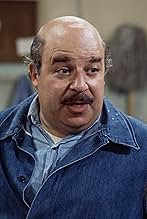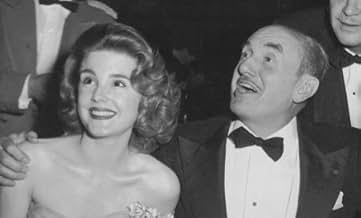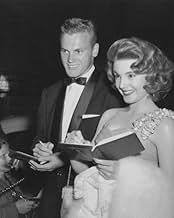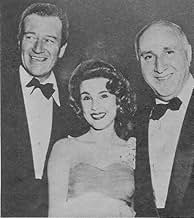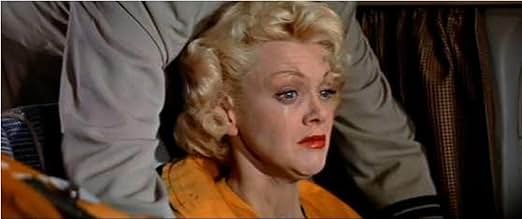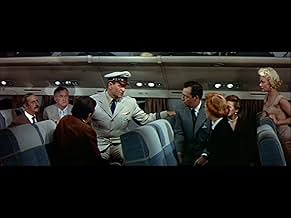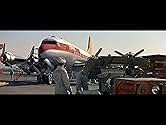IMDb RATING
6.6/10
6.9K
YOUR RATING
When a commercial airliner develops engine problems on a trans-Pacific flight and the pilot loses his nerve, it is up to the washed-up co-pilot Dan Roman to bring the plane in safely.When a commercial airliner develops engine problems on a trans-Pacific flight and the pilot loses his nerve, it is up to the washed-up co-pilot Dan Roman to bring the plane in safely.When a commercial airliner develops engine problems on a trans-Pacific flight and the pilot loses his nerve, it is up to the washed-up co-pilot Dan Roman to bring the plane in safely.
- Won 1 Oscar
- 5 wins & 7 nominations total
Pedro Gonzalez Gonzalez
- Gonzales
- (as Gonzalez Gonzalez)
Featured reviews
I went to the DVD premiere screening of THE HIGH AND THE MIGHTY tonight (12 June 2005) at Paramount studios. It was a big red-carpet event, and I saw a number of people associated with the film there, though there are a scant handful of the cast still surviving. Pedro Gonzalez-Gonzalez, William Campbell, and Robert Easton were there, and from bits of applause during the screening, I suspect that a few others were there as well. Of course, all of the major character players are gone: Wayne, Stack, Trevor, Day, Sterling, Harris, Newton, Brian, Kelly, Blackmer, and Qualen. Other than Karen Sharpe and William Schallert, I'm not certain whether anyone yet unmentioned is still alive. Doe Avedon probably is (she was really lovely as the flight attendant).
As some have speculated, there's no way for this film to live up to the hype that has grown up because of its near-forty year unavailability. It's been beautifully restored. The picture quality seems to my uneducated eye to be impeccable, and the sound is really magnificent. And there are some moments of nice performance, particularly by Wayne, Robert Stack, Jan Sterling, and John Qualen. But as much as I would love to say this is a resurrected masterpiece, it simply isn't possible for me to do so honestly. After AIRPLANE!, I'm not sure it's reasonable to expect people to take a Fifties airliner disaster movie seriously. But the level of corn and hokum and treacle and syrup in which the film wallows (especially in the primary sections dealing with the passengers rather than the crew) is simply intolerable in today's world. I'm not referring to the fact that it's a different practical world now, one in which it would be ludicrous to show a passenger pulling a gun on another passenger on an airliner of today. I'm referring rather to the simple unbelievability of the human behavior exhibited. I'm willing to accept a passenger getting aboard a trans-Pacific airliner with a gun in his pocket in 1954. I'm not willing to accept him pulling that gun, threatening other passengers with it, having it taken from him, and later having it handed back to him just because he says, "I'm all right now, I've calmed down." Phil Harris, fifty at the time and looking sixty, plays a 38-year-old, and 43-year-old Ann Doran plays his 30-year-old wife. Laraine Day berates her husband and demands a divorce, and good ol' Phil says to the husband, "You think you got problems?" and proceeds to tell him about how rain and crummy hotels ruined his vacation, and the husband (John Howard) thus sees his own life in a new perspective. Every cliché imaginable comes into play, and rarely is there a moment that can be easily swallowed, even with Herculean efforts to place oneself mentally in the zeitgeist of the film.
Only in the cockpit are things comparatively realistic and believable, and even there big pills must be swallowed. One of the reasons John Wayne comes off so well in this film is he has relatively little to say. It's probably the lowest line-count of any of Wayne's leading roles, and thus unsaddled with the maudlinities and sappiness of the dialog the passengers are stuck with, he comes off better than anyone in the picture. Spencer Tracy was supposed to play Wayne's role but turned it down (according to various stories) either because he thought the script was lousy or he didn't want to work for taskmaster William Wellman. I'm betting on the former reason.
There are still things to like in THE HIGH AND THE MIGHTY (Dimitri Tiomkin's Oscar-winning score among them), but an awful lot of people have been waiting forty years to see this "masterwork" again, and an awful lot of them are going to be either seriously disappointed or forced to convince themselves that it's not as bad as it seems.
As some have speculated, there's no way for this film to live up to the hype that has grown up because of its near-forty year unavailability. It's been beautifully restored. The picture quality seems to my uneducated eye to be impeccable, and the sound is really magnificent. And there are some moments of nice performance, particularly by Wayne, Robert Stack, Jan Sterling, and John Qualen. But as much as I would love to say this is a resurrected masterpiece, it simply isn't possible for me to do so honestly. After AIRPLANE!, I'm not sure it's reasonable to expect people to take a Fifties airliner disaster movie seriously. But the level of corn and hokum and treacle and syrup in which the film wallows (especially in the primary sections dealing with the passengers rather than the crew) is simply intolerable in today's world. I'm not referring to the fact that it's a different practical world now, one in which it would be ludicrous to show a passenger pulling a gun on another passenger on an airliner of today. I'm referring rather to the simple unbelievability of the human behavior exhibited. I'm willing to accept a passenger getting aboard a trans-Pacific airliner with a gun in his pocket in 1954. I'm not willing to accept him pulling that gun, threatening other passengers with it, having it taken from him, and later having it handed back to him just because he says, "I'm all right now, I've calmed down." Phil Harris, fifty at the time and looking sixty, plays a 38-year-old, and 43-year-old Ann Doran plays his 30-year-old wife. Laraine Day berates her husband and demands a divorce, and good ol' Phil says to the husband, "You think you got problems?" and proceeds to tell him about how rain and crummy hotels ruined his vacation, and the husband (John Howard) thus sees his own life in a new perspective. Every cliché imaginable comes into play, and rarely is there a moment that can be easily swallowed, even with Herculean efforts to place oneself mentally in the zeitgeist of the film.
Only in the cockpit are things comparatively realistic and believable, and even there big pills must be swallowed. One of the reasons John Wayne comes off so well in this film is he has relatively little to say. It's probably the lowest line-count of any of Wayne's leading roles, and thus unsaddled with the maudlinities and sappiness of the dialog the passengers are stuck with, he comes off better than anyone in the picture. Spencer Tracy was supposed to play Wayne's role but turned it down (according to various stories) either because he thought the script was lousy or he didn't want to work for taskmaster William Wellman. I'm betting on the former reason.
There are still things to like in THE HIGH AND THE MIGHTY (Dimitri Tiomkin's Oscar-winning score among them), but an awful lot of people have been waiting forty years to see this "masterwork" again, and an awful lot of them are going to be either seriously disappointed or forced to convince themselves that it's not as bad as it seems.
This is a predecessor in the "Airport" series that achieved splendor in the 70s and 80s . It's exciting and entertaining but overlong , full clichés and stereotypes with passable acting by all star cast . The 2-year best seller written by Ernest K Gann blasts to the screen with every kind of love , thrills , and intrigue . During the initial scenes in Hawaii, characters are shown showing passports prior to boarding the airplane (this is because at the time the movie was filmed, Hawaii was not yet an actual state) . As when a commercial airliner develops engine problems on a trans-Pacific voyage , then a pilot called captain Sullivan (Robert Stack ; producer John Wayne chose Robert Cummings as his co-star for the role ; Director William A. Wellman, however, overrode his producer and chose Stack for the part) loses his nerve but co-pilot named Dan Roman (John Wayne) gets to bring the plane in safely . Meanwhile , the passengers are helped by a flight attendant named Lydia Rice (Laraine Day) but suffer every range of problems and remember by means of flashbacks , such as May Holst (Claire Trevor) , Clara Joseph (Ann Doran) , Jose Locota (John Qualen) , Frank Briscoe (Paul Fix) , Gustave Pardee (Robert Newton), Ed Joseph (Phil Harris) and Sally McKee (Jan Sterling, reportedly shaved her eyebrows for her role in the film and they never grew back) , among others . The airplane heading to San Francisco from Hawaii has a dangerous journey .
The picture contains drama , suspense , moderate tension and is quite entertaining although with some flaws and gaps . Plastic acting and stock characters detailing a hectic flight . The film is detailing hectic flighty piloted by a nervous pilot and the relationship among passengers . All clichéd and stock roles with regurgitation of all usual stereotypical situations from disaster films . John Wayne's role was first offered to Spencer Tracy. However, Tracy, a liberal Democrat who fiercely opposed the blacklisting of alleged "subversives" in Hollywood that was rampant at the time, wanted nothing to do with Wayne, an arch-conservative Republican who strongly supported blacklisting and whose Batjac company was producing the film, and turned the part down. Filmmaker Wellman was an expert pilot , as during his World War I service as an aviator and shooting various pictures about aviation theme such as ¨Wings¨, ¨The young eagles¨, ¨Central airport¨ , ¨Island in the Sky¨ and ¨Lafayette Escadrille¨ . In the 1950s Wellman's best later films starred John Wayne, including this influential aviation picture for which he achieved his third and last best director Oscar nomination . Colourful cinematography ,and final film of veteran cinematographer Archie Stout ; furthermore cameraman helper William Clothier , being John Wayne's first film in CinemaScope. Emotive as well as unforgettable musical score by Dimitri Tiomkin , the lyrics to the famed title song are only heard at the very end, are sung by a large choral group.
This old-fashioned motion picture was professionally directed by William A Wellman . He was called "Wild Bill" during his World War I service as a pilot , a nickname that persisted in Hollywood due to his larger-than-life personality and lifestyle . Wellman was an expert in all kind of genres as Gangster, drama , Film Noir , Western and adept at comedy as he was at macho material , helming the original ¨ A star is born ¨(1937) (for which he won his only Oscar, for best original story) and the biting satire ¨Nothing sacred¨ (1937) , both of which starred Fredric March for producer David O. Selznick . Both movies were dissections of the fame game, as was his satire ¨Roxie Hart¨ (1942), which reportedly was one of Stanley Kubrick's favorite films. During World War Two Wellman continued to make outstanding films, including ¨Ox-Bow incident¨ (1943) and ¨Story of G.I.Joe¨(1945), and after the war he turned out another war classic, ¨Battleground¨ (1949). His final film hearkened back to his World War One service, ¨The Lafayette squadron¨ (1958), which featured the unit in which Wellman had flown . He retired as a director after making the film, reportedly enraged at Warner Bros.' post-production tampering with a movie that meant so much to him .
The picture contains drama , suspense , moderate tension and is quite entertaining although with some flaws and gaps . Plastic acting and stock characters detailing a hectic flight . The film is detailing hectic flighty piloted by a nervous pilot and the relationship among passengers . All clichéd and stock roles with regurgitation of all usual stereotypical situations from disaster films . John Wayne's role was first offered to Spencer Tracy. However, Tracy, a liberal Democrat who fiercely opposed the blacklisting of alleged "subversives" in Hollywood that was rampant at the time, wanted nothing to do with Wayne, an arch-conservative Republican who strongly supported blacklisting and whose Batjac company was producing the film, and turned the part down. Filmmaker Wellman was an expert pilot , as during his World War I service as an aviator and shooting various pictures about aviation theme such as ¨Wings¨, ¨The young eagles¨, ¨Central airport¨ , ¨Island in the Sky¨ and ¨Lafayette Escadrille¨ . In the 1950s Wellman's best later films starred John Wayne, including this influential aviation picture for which he achieved his third and last best director Oscar nomination . Colourful cinematography ,and final film of veteran cinematographer Archie Stout ; furthermore cameraman helper William Clothier , being John Wayne's first film in CinemaScope. Emotive as well as unforgettable musical score by Dimitri Tiomkin , the lyrics to the famed title song are only heard at the very end, are sung by a large choral group.
This old-fashioned motion picture was professionally directed by William A Wellman . He was called "Wild Bill" during his World War I service as a pilot , a nickname that persisted in Hollywood due to his larger-than-life personality and lifestyle . Wellman was an expert in all kind of genres as Gangster, drama , Film Noir , Western and adept at comedy as he was at macho material , helming the original ¨ A star is born ¨(1937) (for which he won his only Oscar, for best original story) and the biting satire ¨Nothing sacred¨ (1937) , both of which starred Fredric March for producer David O. Selznick . Both movies were dissections of the fame game, as was his satire ¨Roxie Hart¨ (1942), which reportedly was one of Stanley Kubrick's favorite films. During World War Two Wellman continued to make outstanding films, including ¨Ox-Bow incident¨ (1943) and ¨Story of G.I.Joe¨(1945), and after the war he turned out another war classic, ¨Battleground¨ (1949). His final film hearkened back to his World War One service, ¨The Lafayette squadron¨ (1958), which featured the unit in which Wellman had flown . He retired as a director after making the film, reportedly enraged at Warner Bros.' post-production tampering with a movie that meant so much to him .
Has there ever been a more majestic film score? Slightly melancholy and beautifully haunting, Dimitri Tiomkin's Academy Award winning music gives us a grand and expansive auditory experience comparable perhaps to what a soaring eagle must feel, in its own way, as it glides high above a landscape of the mundane and the mediocre.
In the early 50s, people were just getting used to the idea that they could climb aboard a big man-made eagle and soar above cars, buses, and trains. It was a thrilling, but scary, idea, not unlike traveling on the Titanic. And so, with "The High And The Mighty", Hollywood created the first big budget movie that conveyed the idea of risk, in commercial air travel. Throughout the film, the overriding emotion is insecurity, not only among passengers but among the crew as well. Since the film was a cinematic prototype, I can see how its nerve-wracking story would appeal to moviegoers of that era. The film's angelic theme music thus provided inspiration to help viewers overcome their fear of something new and different, something potentially life threatening.
Since the early 50s, air travel has lost its sense of adventure. The film to us seems quaint and dated. What seemed odd to me, for example, was the ticket counter. The pace was leisurely, and the attention was very personal. Then, on board the plane, the stewardess made sure that the passengers got personalized attention. At one point, even the captain, upon request, reassured a nervous passenger. Those were the days.
First time viewers also need to be aware that this film is talky and dreamily melodramatic. The emphasis is on story and acting, not special effects or high-powered action. And then there is that final Act. It is different perhaps from what most of us probably would expect. But again, we must take into account the era in which the film was made.
Fifty years after its release, "The High And The Mighty", as a film, cannot compete with its own theme music. The sweeping orchestration, like music generally, transcends time and spans the generations. By contrast, technology, and mankind's reaction to technology, changes. The film's story thus has a different meaning to us than it did to the original moviegoers. If you can place the film in its proper historic context, you have a better chance of appreciating the film for what it was then, not for what it is now.
In the early 50s, people were just getting used to the idea that they could climb aboard a big man-made eagle and soar above cars, buses, and trains. It was a thrilling, but scary, idea, not unlike traveling on the Titanic. And so, with "The High And The Mighty", Hollywood created the first big budget movie that conveyed the idea of risk, in commercial air travel. Throughout the film, the overriding emotion is insecurity, not only among passengers but among the crew as well. Since the film was a cinematic prototype, I can see how its nerve-wracking story would appeal to moviegoers of that era. The film's angelic theme music thus provided inspiration to help viewers overcome their fear of something new and different, something potentially life threatening.
Since the early 50s, air travel has lost its sense of adventure. The film to us seems quaint and dated. What seemed odd to me, for example, was the ticket counter. The pace was leisurely, and the attention was very personal. Then, on board the plane, the stewardess made sure that the passengers got personalized attention. At one point, even the captain, upon request, reassured a nervous passenger. Those were the days.
First time viewers also need to be aware that this film is talky and dreamily melodramatic. The emphasis is on story and acting, not special effects or high-powered action. And then there is that final Act. It is different perhaps from what most of us probably would expect. But again, we must take into account the era in which the film was made.
Fifty years after its release, "The High And The Mighty", as a film, cannot compete with its own theme music. The sweeping orchestration, like music generally, transcends time and spans the generations. By contrast, technology, and mankind's reaction to technology, changes. The film's story thus has a different meaning to us than it did to the original moviegoers. If you can place the film in its proper historic context, you have a better chance of appreciating the film for what it was then, not for what it is now.
"The High and the Mighty", the granddaddy of air disaster movies, often falls into almost campy melodrama, but under the direction of the legendary 'Wild Bill' Wellman, and punctuated by one of Dimitri Tiomkin's most bombastic yet exciting scores (earning him an Oscar), the film maintains such a level of intensity that it remains constantly entertaining. With John Wayne heading an ensemble cast (including several co-stars from the past, as well as personal friends), it is certainly an essential for any 'Duke' film library.
Produced by Wayne-Fellows Productions, and 'owned', eventually, by the Wayne family's Batjac Productions (along with "Hondo", "McLintock!", and "Island in the Sky"), the film was a BIG hit, when released, and offered one of Wayne's better performances, then gained even greater stature as it was unseen for a generation. I've always held the belief that the family planned to release the entire quartet of films in 2007, to mark the centennial of Duke's birth, but two events changed the plan; first, an unauthorized, 'remixed' VHS version of "McLintock!" was released, with rumors that a version of "Hondo" was also in the works, forcing Michael Wayne, then President of Batjac, to release authorized VHS versions of the two films, rather than have the market glutted with bad copies; second, with Michael's death, in 2003, the Wayne family rethought the master plan, deciding to release the entire collection on DVD earlier. For whatever reason, seeing "The High and the Mighty" again is a cause to celebrate!
Based on Ernest K. Gann's bestseller (which would inspire Arthur Hailey's later novel, "Airport"), the story centers around a routine commercial flight between Honolulu and San Francisco, which becomes a life-and-death drama when one engine explodes, just beyond the 'Point of No Return'. With limited fuel, in deteriorating weather, the crisis brings out the best and worst in both passengers and crew.
Wayne as the co-pilot, is quite good, playing a character older than he actually was (the role had been written for Spencer Tracy, who pulled out, just prior to filming); Robert Stack almost foreshadows his character in "Airplane!" as the no-nonsense pilot who goes ballistic when stressed. For cockpit 'overacting', however, the award has to go to Wally Brown, as the navigator, with his bugged-out eyes, visions of his shrewish wife, and WILDLY unruly hair...
While the passengers are all stereotypes, several actors are quite good in their roles, with standout performances by Claire Trevor and Jan Sterling (both Oscar-nominated), Robert Newton, Paul Kelly, and Paul Fix. While Phil Harris attempts to inject humor into his role, it only works sporadically (and Ann Doran, as his wife, plays 'hysterical' so convincingly that you want to STRANGLE her!) Laraine Day, third-billed (and, with Trevor, a previous Wayne leading lady), is remarkably unlikable as a rich wife with a 'bought' husband (John Howard); Sidney Blackmer plays the 'mandatory' unbalanced type; and veteran character actor John Qualen adds another 'ethnic' portrayal to his long list, as a Latin family man (with a Norwegian accent!) A bit of trivia: The young boy on board was portrayed by director Wellman's son!
Almost as fascinating as the story is seeing how much has changed, since the film was released; the plane's 'tail' is controlled by pulleys and wires in a rear compartment; the sole flight attendant is a "stewardess"; and everyone smokes (especially in the cockpit). On a more somber note, there is NO security, and one passenger boards easily, carrying a gun. It is, sadly, a wiser world, today...
While no one would ever accuse "The High and the Mighty" of being a film classic, it's role in creating the 'airplane disaster' genre can't be denied, and it continues to be a vastly enjoyable John Wayne feature.
It's great to have it back!
Produced by Wayne-Fellows Productions, and 'owned', eventually, by the Wayne family's Batjac Productions (along with "Hondo", "McLintock!", and "Island in the Sky"), the film was a BIG hit, when released, and offered one of Wayne's better performances, then gained even greater stature as it was unseen for a generation. I've always held the belief that the family planned to release the entire quartet of films in 2007, to mark the centennial of Duke's birth, but two events changed the plan; first, an unauthorized, 'remixed' VHS version of "McLintock!" was released, with rumors that a version of "Hondo" was also in the works, forcing Michael Wayne, then President of Batjac, to release authorized VHS versions of the two films, rather than have the market glutted with bad copies; second, with Michael's death, in 2003, the Wayne family rethought the master plan, deciding to release the entire collection on DVD earlier. For whatever reason, seeing "The High and the Mighty" again is a cause to celebrate!
Based on Ernest K. Gann's bestseller (which would inspire Arthur Hailey's later novel, "Airport"), the story centers around a routine commercial flight between Honolulu and San Francisco, which becomes a life-and-death drama when one engine explodes, just beyond the 'Point of No Return'. With limited fuel, in deteriorating weather, the crisis brings out the best and worst in both passengers and crew.
Wayne as the co-pilot, is quite good, playing a character older than he actually was (the role had been written for Spencer Tracy, who pulled out, just prior to filming); Robert Stack almost foreshadows his character in "Airplane!" as the no-nonsense pilot who goes ballistic when stressed. For cockpit 'overacting', however, the award has to go to Wally Brown, as the navigator, with his bugged-out eyes, visions of his shrewish wife, and WILDLY unruly hair...
While the passengers are all stereotypes, several actors are quite good in their roles, with standout performances by Claire Trevor and Jan Sterling (both Oscar-nominated), Robert Newton, Paul Kelly, and Paul Fix. While Phil Harris attempts to inject humor into his role, it only works sporadically (and Ann Doran, as his wife, plays 'hysterical' so convincingly that you want to STRANGLE her!) Laraine Day, third-billed (and, with Trevor, a previous Wayne leading lady), is remarkably unlikable as a rich wife with a 'bought' husband (John Howard); Sidney Blackmer plays the 'mandatory' unbalanced type; and veteran character actor John Qualen adds another 'ethnic' portrayal to his long list, as a Latin family man (with a Norwegian accent!) A bit of trivia: The young boy on board was portrayed by director Wellman's son!
Almost as fascinating as the story is seeing how much has changed, since the film was released; the plane's 'tail' is controlled by pulleys and wires in a rear compartment; the sole flight attendant is a "stewardess"; and everyone smokes (especially in the cockpit). On a more somber note, there is NO security, and one passenger boards easily, carrying a gun. It is, sadly, a wiser world, today...
While no one would ever accuse "The High and the Mighty" of being a film classic, it's role in creating the 'airplane disaster' genre can't be denied, and it continues to be a vastly enjoyable John Wayne feature.
It's great to have it back!
I saw The High and the Mighty when I was 16 in a theater when it first came out. Every woman walked out in love with John Wayne and every man wanted to BE John Wayne. We all hummed, whistled or la-la-la'd the theme song all the way home.
I would love to add The High and the Mighty to my collection of John Wayne films, but the Wayne Family Trust has got to allow this film to be converted to either a DVD or a VHS format. I know they are waiting for the time when they can squeeze the maximum number of dollars out of it, but if they aren't careful, they will wait too long and the world will have moved so far beyond the ideas, concepts and technology of the 50's that the film will not appeal to the younger generation of purchasers of movies.
It's more than just Wayne's performance that is being withheld from the public. I am also a great admirer of the work of the great British actor, Robert Newton and he turned in a marvelous performance here. So did Jan Sterling, Claire Trevor, Paul Fix, Lorraine Day and all the rest of the cast. Their fans deserve to see these actors in this film too. The only actor I could live without is Robert Stack. He has never done a thing for me. But the film as a whole is wonderful and should be released...ASAP
I would love to add The High and the Mighty to my collection of John Wayne films, but the Wayne Family Trust has got to allow this film to be converted to either a DVD or a VHS format. I know they are waiting for the time when they can squeeze the maximum number of dollars out of it, but if they aren't careful, they will wait too long and the world will have moved so far beyond the ideas, concepts and technology of the 50's that the film will not appeal to the younger generation of purchasers of movies.
It's more than just Wayne's performance that is being withheld from the public. I am also a great admirer of the work of the great British actor, Robert Newton and he turned in a marvelous performance here. So did Jan Sterling, Claire Trevor, Paul Fix, Lorraine Day and all the rest of the cast. Their fans deserve to see these actors in this film too. The only actor I could live without is Robert Stack. He has never done a thing for me. But the film as a whole is wonderful and should be released...ASAP
Did you know
- TriviaErnest Gann's novel clearly indicates that the character of Sally McKee has resorted to prostitution in order to survive. The film version, made at the height of Hollywood censorship, was unable to explicitly state this; however, Gann slyly managed to insinuate the information during Sally's entrance, wherein two sailors at the Honolulu airport recognize her and pointedly remark, "Hey, look! Remember?"
- GoofsNear the end of the film, Air Traffic Control clears the aircraft to land on "runway 39" This is impossible. Runways are numbered are within 10 degrees of their actual magnetic heading, and since there are only 360 degrees on the compass, the highest runway number possible is "runway 36".
- Quotes
Alsop: She may be put together with paste and flour, but that woman has something. What would you say it was?
Miss Spalding: Practice. Plenty of practice.
- Alternate versionsThe song "The High and the Mighty" (with lyrics) does not appear in the original 1954 release of this film. However, the studio wanted the hugely popular, chart-topping song to be nominated for the Best Song Academy Award that year. According to AMPAS regulations, the song could not be nominated because it was no officially sung in the film, even if would be heard elsewhere. To satisfy these regulations, a version was released towards the tail-end of 1954 for a few nights only with the song inserted into an Exit Music. The Academy then decided to give the song a nomination on the basis of these screenings. The song lost to "Three Coins in a Fountain".
- ConnectionsEdited into La police fédérale enquête (1959)
- How long is The High and the Mighty?Powered by Alexa
Details
Box office
- Budget
- $1,470,000 (estimated)
- Gross worldwide
- $4,334
- Runtime
- 2h 27m(147 min)
- Sound mix
- Aspect ratio
- 2.55 : 1
Contribute to this page
Suggest an edit or add missing content


